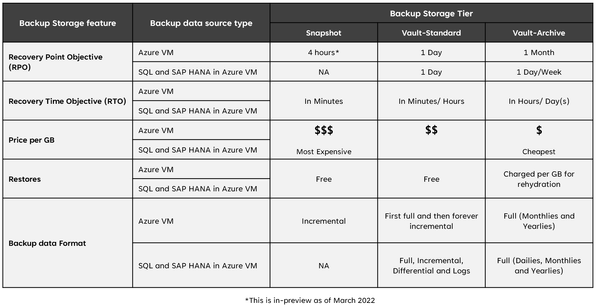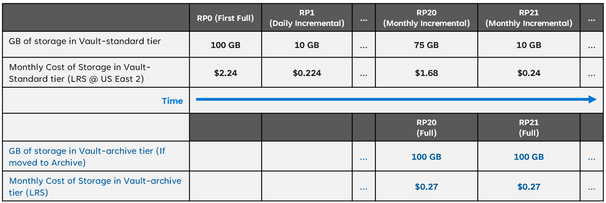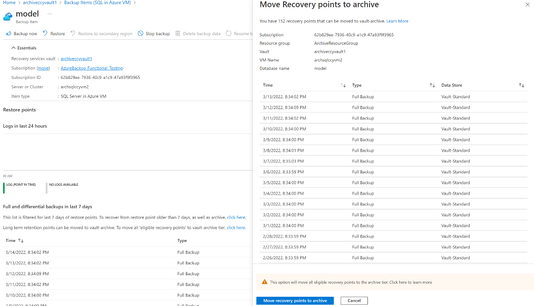Achieve cost-effectiveness using vault-archive tier for Azure Backup
Published Wednesday, April 20, 2022

As organizations are scaling up their cloud adoption, the accompanying cost increase becomes a constant hindrance towards a seamless cloud footprint expansion. The situation is no different when it comes to cloud backup. As more organizations start backing up their resources in cloud, efficient cost management techniques become one of the key pivots that uniquely differentiates one backup service provider from another.
Azure Backup already offers a series of capabilities that address your cost-related concerns as you decide to scale up your cloud backup usage. The latest addition to this list is Azure Backup’s capability to move your long-term recovery points to a low-cost archive tier. Azure Backup’s storage options are presented in 3 broad tiers
- Snapshot/Operational tier – The backup data in this tier continues to be in your own storage accounts and resides close to the original data source.
- Vault-Standard tier – This is the default tier in Azure Backup’s vaults, and this is where all your backup data goes to for all applicable data sources.
- Vault-Archive tier – This recently introduced tier is the cheapest storage tier for Azure Backup and you can choose to move specific backups from the Vault-standard tier to this tier.
Key Benefits of Vault-Archive tier
- Cost-effective backups – Vault-archive tier is 85%-95% cheaper per GB than Vault-standard tier and can bring down the cost of your long-term backups significantly. The trade-offs are in the form of higher RPO and higher RTO, but this may not be a concern given that most restores tend to happen from recovery points less than 60 days old.
- Flexible lifecycle management of backup data – With the introduction of Vault-archive tier, you have the option to choose specific recovery points that are eligible and move them to the low-cost tier. Additionally, you can move all eligible or recommended RPs with a single click from Azure Portal.
- Additional security – Since Azure Backup stores data only as Full backups in vault-archive tier, it ensures that there are no additional points of failure while trying to recover your old backups.
- Recommendations – Vault-archive tier is designed to store only full backups today. When you move your SQL and SAP HANA full backups of databases, this results in a direct drop in cost of 85%-95% which is the per GB comparison. However, since Azure VM backups are stored as forever incremental in Vault-standard tier, there is an intermediate process to convert these to full backups before moving to Vault-archive tier. During this conversion process, the amount of GB decrease in Vault-standard tier would usually be less than or equal to the amount of GB increase in Vault-archive tier. This difference is a factor of the amount of churn that the VM went through before that backup. A higher churn would mean that moving to the Vault-archive tier would result in higher savings.
Azure Backup provides recommendations for your Azure VM backups to ensure that you always get cost savings when moving your backups to the vault-archive tier. To ensure that you only move recommended recovery points to vault-archive tier, you can use the Azure Portal. Learn more about how recommendations work.
- Integrated restores – Restores from the Vault-Archive tier require the backup data to be rehydrated to the Vault-Standard tier before it can be restored. However, Azure Backup provides you a seamless and integrated experience to restore from recovery points by providing additional parameters in the existing recovery flow by automatically enabling rehydration when necessary. Additionally, you can re-use this rehydrated data and restore it again from the same recovery point, from the vault-standard tier, for free of charge till your set duration expires.
- Management at scale – Azure Backup provides additional management capabilities to move your recovery points to the Vault-archive tier at scale. You can easily move multiple recovery points in a simplified manner using Azure Portal for a single data source and using PowerShell for multiple data sources. Additionally, you can also run the PowerShell scripts in Azure runbooks and schedule them to move your recovery points to Vault-archive tier at scale across your workloads, recovery services vaults and subscriptions. You can also refer to sample scripts from Azure Backup that can be modified to suit your business needs.
Getting Started
You can use Azure Portal, Azure PowerShell, or Azure CLI to move recovery points to the vault-archive tier for your Azure VM, SQL in Azure VM and SAP HANA in Azure VM backups.
Follow the step-by-step guidelines to leverage the vault-archive tier support provided by Azure Backup. With Azure Portal, you can move all your eligible/recommended recovery points to the vault-archive tier with just a single click.
Archive Tier Pricing for Azure Backup
Please refer to the Azure Backup Pricing for Archive tier to learn about costs related to archive tier.
References
- Overview of the Vault-archive tier - Azure Backup - Archive Tier overview - Azure Backup | Microsoft Docs
- How to use Vault-archive tier - Use Archive Tier - Azure Backup | Microsoft Docs
- How Vault-Archive tier works - https://youtu.be/nQnH5mpiz60?t=412
- Support Matrix - Azure Backup - Archive Tier overview - Azure Backup | Microsoft Docs
- Best Practices to save costs - 6 Azure Backup Best Practices to Save Costs - CHARBEL NEMNOM - MVP | MCT | CCSP - Cloud & CyberSecurity
Continue to website...













